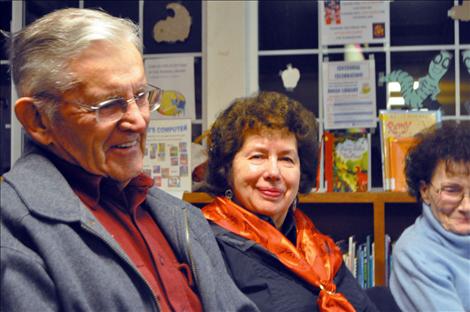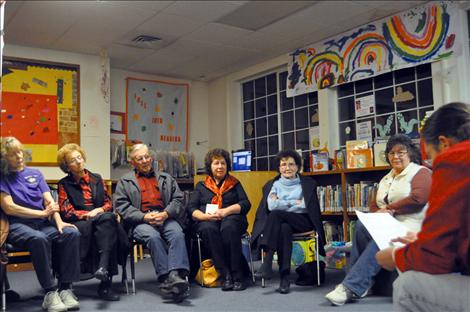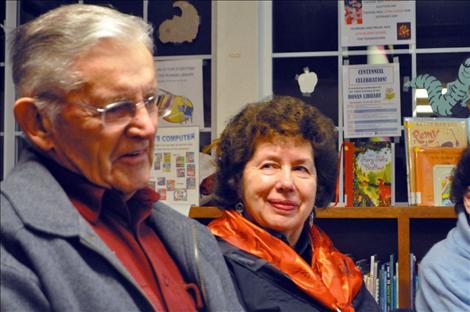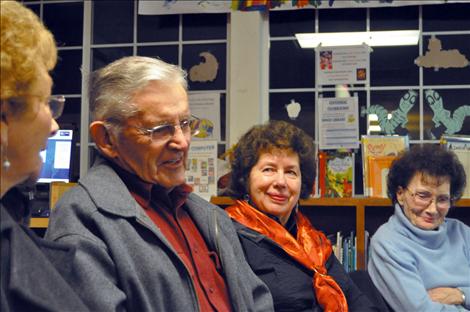Gimme that old time Ronan: residents talk about days gone by
Hey savvy news reader! Thanks for choosing local.
You are now reading
1 of 3 free articles.
RONAN – Brick and mortar seem deceptively permanent and it may be easy to forget that cities, like people, have a life cycle, are constantly changing, and are home to characters who are all, in one way or another, just passing through for a bit of time that keeps plunging forward.
A group of Ronan citizens told tales of nearly nine decades of the city’s history at the conclusion of the Ronan Library’s centennial celebration in November.
For Bill Hocker, 90, the Ronan of his youth was a town in its infancy.
“My folks came here in 1910 to homestead,” Bill said. The land of the Flathead Reservation was newly opened to homesteading and the Hocker family decided to try its hand at farming. “We lived in a place right out of Charlo until 1926, then we went to California that winter and we didn’t plan on coming back here, but we met someone down there who said we’d do better up here. So we came back in 1927.”
Ronan was a different place in those days, staffed with names, faces and buildings that have long since existed only in the minds and hearts of the few who remember.
The Entertainer Cinema bore a different name in those days, and was owned by a woman named Pearl Resner.
“You could see a double feature for a dime,” Bill remembered with a laugh. “Of course, they probably weren’t worth much more than that.”
Going to school in the old days was a lot different than attending the Class B Ronan school that currently exists. A number of small country schoolhouses were scattered throughout the county, and upon graduation from the lower grades students were filtered into the larger Ronan High School.
Phyllis Hocker, Bill’s wife of 64 years, said going to high school was a huge step.
“My grade school was eight years at Round Butte,” Phyllis said. “They had a high school at one time, but that closed in 1917 long before I ever went. It was really quite a jump for me to get on a school bus and come to Ronan where I didn’t know anybody. Five of us had graduated from eighth grade.”
The school’s graduation in 1924 was held in the Gaiety Theater, with graduation being an all-county affair.
Diane Grant has a box full of old programs and mementos that belonged to her parents in their school days.
“I can’t visualize how they got the materials for some of the things,” Grant said. “It amazes me. My dad had a number he wore for his track team and they printed programs for things. We have all this electronic stuff now, but they produced really great things. It was a big thing to go to a prom or a dance.”
Traveling outside of Mission Valley was also something that was rare.
“I can remember driving to Missoula with my folks and you might meet one or two folks, on a busy day,” 82-year-old Al Skogen said. “We didn’t travel much.”
But growing Ronan offered plenty to see. Businesses boomed and busted, their owners living and dying in the town. Sterling Hotel was one of the first businesses in Ronan, but it was eventually torn down. In the era of small dairies, two creameries were born and eventually died as the market for milk moved from small farm providers to mega-facilities.
A sea of friendly faces worked the countertops. Grant remembered going to Phillip’s Hardware store.
“If Mr. Phillips couldn’t find it, then he would go to the basement,” she said. “I always wanted to go down there. I was too shy to ask him then (if I could), but I was convinced there were treasures in that basement. He brought out stuff that probably nobody had looked for in 10 or 15 years, and he would say ‘Well maybe this will work for you?’ He was so energetic when he climbed down. He went in this magic place and came out with neat stuff.”
The city’s green space has also changed.
“This whole block used to be park,” Skogen said of where the library currently sits. “We used to play in the park and there was a bandstand right in the middle, where there is an alley now. The grandstand was built by the WPA.”
A two-room elementary school house called the “Park School” was nestled near the park, and another brick building also held students. Fire drills in the multi-story facility were a hoot for youngsters because it meant scooting down a huge slide that hung off the side of the building.
Food in those days didn’t cost as much, and there were plenty of places to shop around.
“I think a roast beef dinner was 50 cents,” Bill said of Mrs. Koberg’s shop. “They had a good meal there. It was a good little restaurant.”
The place to go for a burger was the Quick Lunch, but you had to go somewhere else for the fries.
“If you wanted french fries, you went to The Corral because you could get them for a dollar,” Grant said. “We’d all put in a dime, ten of us, and we’d get this big plate of french fries. It was like heaven. The Quick Lunch didn’t have a french fryer.”
The list of people who remember the faces and places keeps growing shorter. When Bill’s class held its 70th reunion in 2012, only six classmates were still alive. Some of those have died in the two years since. For those who are still around, the memories are packed in with decades of history.
“I can remember a lot of things, but I don’t remember everything,” Bill joked.
And the changes keep on coming as time keeps turning.
“I know in the eight years I’ve been here, it’s changed a lot,” Librarian Michelle Fenger said.



















